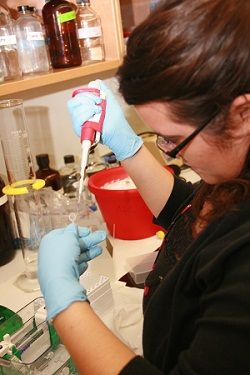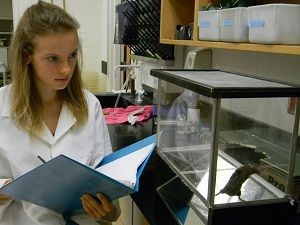 As Michelle Radford ’14 investigates interactions between antimicrobial proteins and DNA in the new senior research lab of Pearce Science Center, she knows that her research mentor, Assistant Professor of Chemistry Maria Craig, isn’t far if she needs assistance. The first phase of renovations in Pearce — completed in winter 2011 — relocated faculty offices adjacent to labs on the first floor and made possible equipment updates and other enhancements that benefit students in and out of the classroom. Still, $6 million remains to be raised to complete upgrades to the building. A positive response from students, faculty, and community members inspires eagerness to finish this core component of Ever Ahead: The Campaign for Mary Baldwin University.
As Michelle Radford ’14 investigates interactions between antimicrobial proteins and DNA in the new senior research lab of Pearce Science Center, she knows that her research mentor, Assistant Professor of Chemistry Maria Craig, isn’t far if she needs assistance. The first phase of renovations in Pearce — completed in winter 2011 — relocated faculty offices adjacent to labs on the first floor and made possible equipment updates and other enhancements that benefit students in and out of the classroom. Still, $6 million remains to be raised to complete upgrades to the building. A positive response from students, faculty, and community members inspires eagerness to finish this core component of Ever Ahead: The Campaign for Mary Baldwin University.
“The availability of resources has increased since the renovation, and they’re better organized. The senior research lab also feels more like our space — where we can do our research outside of areas primarily used for instruction,” said Radford, a chemistry major with an emphasis in biochemistry. “Leading our own research better prepares us for graduate school as a possible next step.”
“The senior research space has brought students together naturally, and they are exchanging ideas more frequently,” said Craig. New equipment, such as a gel imager and fluorescence microscopes, has further modernized Pearce. Another of Craig’s favorite updates is the entranceway, where posters showcase student research.
Pearce Science Center opened in 1970, and while it has remained a thriving research hub over the years, it has needed modern refurbishments to better serve the collaborative faculty-student research environment that is an integral part of the sciences at Mary Baldwin. The first renovation phase included an environmental systems classroom and research lab, a mammalian vivarium, an enhanced imaging suite with electron microscopes, a senior research suite, a new classroom, and a new entrance to the first floor. Also, classrooms on the first and second floors received modifications to meet today’s instructional needs.
Inna Kirilyuk ’14 is working with Assistant Professor of Physics Nadine Gergel-Hackett to build memristors — small, flexible electronic chips that retain memory without power — to better understand the physics behind how they function. The research could revolutionize technologies such as artificial intelligence and computing.
“She is collecting results significant enough to be submitted for presentation at the American Physical Society March Meeting,” said Gergel-Hackett. “Being in an environment that better matches our vision of cutting edge technology is inspiring for students,” she said.
Kirilyuk transferred from community college and chose Mary Baldwin based on small class sizes and frequent interaction with professors. “I wouldn’t have an opportunity for this level of research with such accomplished faculty as an undergraduate at a larger university,” she said.
 A triple major in biology, chemistry, and psychology, Sophia Stone ’14 spends ample time in Pearce. Since the first phase of renovations, she has observed a distinct increase in collaboration among students across academic disciplines. Chemistry and biology students frequently use the research spaces at the same time and can assist and learn from one another, she explained. Under the guidance of Paul Deeble, associate professor of biology, Stone is performing prostate cancer research in hopes of learning how an antimicrobial peptide may affect the invasiveness of cancerous cells.
A triple major in biology, chemistry, and psychology, Sophia Stone ’14 spends ample time in Pearce. Since the first phase of renovations, she has observed a distinct increase in collaboration among students across academic disciplines. Chemistry and biology students frequently use the research spaces at the same time and can assist and learn from one another, she explained. Under the guidance of Paul Deeble, associate professor of biology, Stone is performing prostate cancer research in hopes of learning how an antimicrobial peptide may affect the invasiveness of cancerous cells.
She is also teaming up with Louise Freeman, assistant professor of psychology, on an examination of sexual differentiation in the Asian musk shrew. This research could be important in better understanding the role testosterone plays in sexual differentiation in the brains of primates.
“Some of the most valuable skills I’ve acquired at Mary Baldwin have come from my time spent in Pearce. I’ve learned how to think critically, to become a better researcher, and how to mentor other students who are interested in scientific research. When I walk into a lab and things have gone wrong — unanticipated problems have arisen — I have to work with my faculty advisors to find a solution, and that makes me a better researcher. Research is full of trial and error, but through the process, we learn so much and eventually find our way,” Stone said.
The new mammalian vivarium — including four rooms in a suite with its own ventilation system — allows Freeman to separate male and female musk shrews for a more controlled observation environment. While Freeman enjoys her research, the skill development student researchers undergo at Mary Baldwin is just as gratifying. “It’s remarkable what our undergraduates can do,” she said.
The second and final phase of the renovation will target the third and fourth floors of Pearce, where chemistry and physics labs will receive upgrades. Classrooms will be reconfigured, modern hoods and improved ventilation will be installed, and other updates will round out a contemporary, well-equipped science center. With the launch of the Murphy Deming College of Health Sciences (MDCHS) in August 2014, Craig anticipates increased interest in the sciences at Mary Baldwin. The completion of the Pearce renovation will be essential to best supporting future MDCHS students at the undergraduate level.
“We’re excited about the future and look forward to the potential growth Murphy Deming may bring,” Craig said.